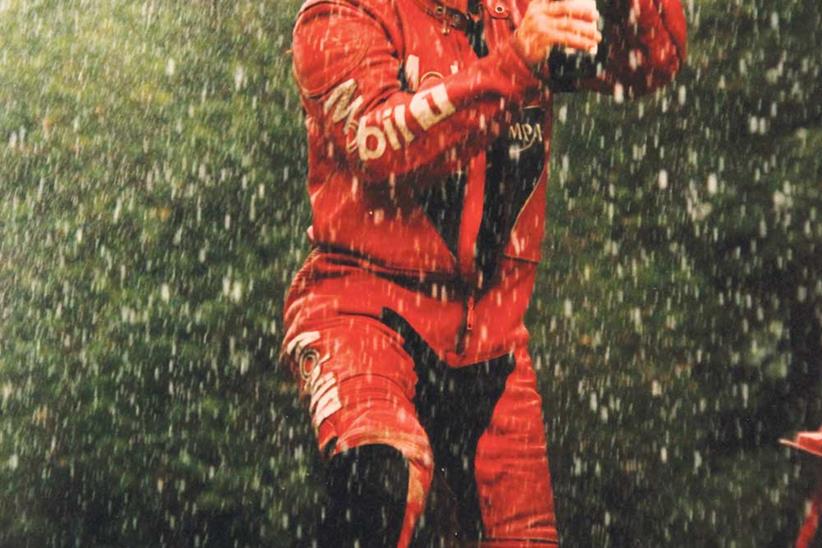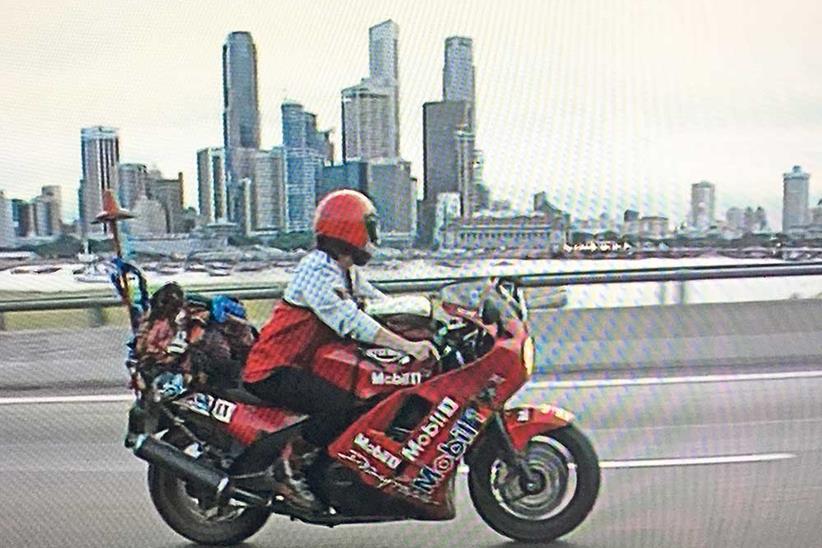19,930 miles around the world in 31 days 20hrs
June 9, 1997 Nick Sanders becomes the fastest man to circumnavigate the globe
These days Nick Sanders is a legend for his record-breaking global rides, but back in 1997 he was an unknown entity. He hadn’t written any motorcycle books or blogged any adventures. He was just an ambitious guy with a plan to “push the boundaries”. This is the story of how he and a Triumph Daytona 900 circled the world in just 764 hours.
The Eyewitnesses
Nick Sanders
Endurance adventurer, speaker and tour leader
Eric Michell
Film and TV producer, was the first to bring Sanders to our screens
Bruno Tagliaferri
National Sales Manager for Triumph Motorcycles
Nick Sanders ‘The route was determined by the Guinness Book of Records: they say you have to do a minimum of 18,000 miles, you have to go round in the same direction and use the same bike with the same engine. You also have to touch an antipodal point, in this case Madrid and Auckland. But I also wanted to include India as it’s such a tough country to cross. You can’t do more than 600 miles per day there, and a thousand is impossible. Not only did that make it the fastest but in my opinion it was also the hardest.’
Eric Michell ‘I’d first met Nick in the mid-70s when he was trying to fly around the world on a microlight. We tried to put something together, but it never came off. I lost touch with him completely… until about two months before he was due to do the 1997 circumnavigation. I came into my office one morning and happened to glance down at a motorcycle magazine one of my researchers was reading. On it was a guy with Mobil written across his red leathers sitting atop a bike, I thought: “Bloody hell! It’s Nick!” We then spent about a week trying to track him down.’
Bruno Tagliaferri ‘Nick was an unknown quantity – however, he came highly recommended from one of the team at Top Gear, whom he’d done some work with. We were told he was no exaggerator, that he was serious and committed. That appealed as we were quite young in those days and had a lot to prove, and we were as keen for credibility as he was. It was clear that he was a real adventurer.’
Sanders ‘The ride involved crossing Europe to Istanbul, then flying to Bombay. From there I crossed India to Delhi and Calcutta, flew from Calcutta to Bangkok, then rode down to Singapore and flew to Perth. I rode up the west coast to Broome, then Katherine, down the Stuart Highway to Adelaide and across to Melbourne and Sydney. New Zealand was next from Christchurch to Auckland, then from Anchorage in Alaska down to San Antonio in Texas and back up to New York. Finally, a flight to Lisbon to ride to Madrid and back up to Calais.’
Michell ‘Having found him, we had a frantic get together, making last minute plans to film this thing. He brought his bike over to our studios where we fitted some camera bracketry. Then I had to train him to film himself. We managed to get one of the first Panasonic cameras with the Mini DV tape system, it was just about small enough to mount on the bike. We had one test and it was time to go.’
Sanders ‘The riding itself was challenging. I’d only ridden 50,000 miles by that point (now it’s more like 600,000) and the Triumph Daytona 900 was a good bike but it was early technology and it was heavy. You’ve got to start somewhere though, and Triumph did a good job.’
Tagliaferri ‘We lent Nick the Daytona and from then on we hardly needed to support him. The whole trip was solo without a support vehicle and it was well planned. When he got back we stripped the bike and Mobil put it on display – it was seriously still in good condition. It was a very over-engineered bike, of course. They were all built solidly. They were chunky and all the components were very ‘proven’. The challenge for us after that point became to make it lighter and quicker.’
Michell ‘Nick had a beacon on his bike which gave us his position, it was really advanced technology for the time. We were flying tapes back from him around the world and editing the show and briefing him as he went. It was a logistically incredibly difficult.’
Sanders ‘Before you do something like this people don’t know what to think, or if you’re capable of doing it. Everyone can attempt something but they don’t always succeed. So the enthusiasm for the project started when I got back. And that was in a big way thanks to the resulting television series. It gave me a certain amount of celebrity, money and – more importantly – credibility.’
Michell ‘It was extraordinary. Apart from the laptop and cameras it was just him, his leathers, a toothbrush, a credit card and a bit of cash in his sock. You wanted to stay upwind of him when he got back, I tell you that!’






